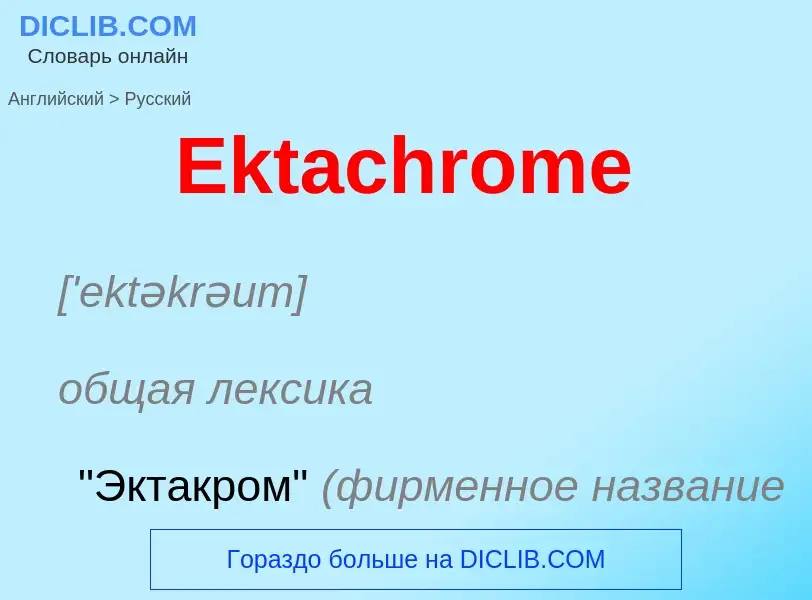Vertaling en analyse van woorden door kunstmatige intelligentie ChatGPT
Op deze pagina kunt u een gedetailleerde analyse krijgen van een woord of zin, geproduceerd met behulp van de beste kunstmatige intelligentietechnologie tot nu toe:
- hoe het woord wordt gebruikt
- gebruiksfrequentie
- het wordt vaker gebruikt in mondelinge of schriftelijke toespraken
- opties voor woordvertaling
- Gebruiksvoorbeelden (meerdere zinnen met vertaling)
- etymologie
Ektachrome - vertaling naar russisch
['ektəkrəum]
общая лексика
"Эктакром" (фирменное название цветной фотоплёнки)
Wikipedia

Ektachrome is a brand name owned by Kodak for a range of transparency, still, and motion picture films previously available in many formats, including 35 mm and sheet sizes to 11 × 14 inch size. Ektachrome has a distinctive look that became familiar to many readers of National Geographic, which used it extensively for color photographs for decades in settings where Kodachrome was too slow. In terms of reciprocity characteristics, Ektachrome is stable at shutter speeds between ten seconds and 1/10,000 of a second.
Ektachrome, initially developed in the early 1940s, allowed professionals and amateurs alike to process their own films. It also made color reversal film more practical in larger formats, and the Kodachrome Professional film in sheet sizes was later discontinued.
High Speed Ektachrome, announced in 1959 provided an ASA 160 color film, which was much faster than Kodachrome. In 1968, Kodak started offering push processing of this film, allowing it to be used at ASA 400.
Whereas the development process used by Kodachrome is technically intricate and beyond the means of amateur photographers and smaller photographic labs, Ektachrome processing is simpler, and small professional labs could afford equipment to develop the film. Many process variants (designated E-1 through E-6) were used to develop it over the years. Modern Ektachrome films are developed using the E-6 process, which can be carried out by small labs or by a keen amateur using a basic film tank and tempering bath to maintain the temperature at 100 °F (38 °C).
Ektachrome has occasionally been used as a motion picture film stock, such as in the 1999 film Three Kings and the 2006 film Inside Man, in which each used cross processing in C-41 color negative chemistry to give a unique appearance. It was also used in the 1998 film Buffalo '66, although it was processed regularly for this.
Several years before Ektachrome's discontinuation, some of Kodak's consumer E-6 films were rebranded as Elite Chrome. In late 2009, Kodak announced the discontinuation of Ektachrome 64T (EPY) and Ektachrome 100 Plus (EPP) films, citing declining sales. On February 4, 2011, Kodak announced the discontinuance of Ektachrome 200 on its website. On March 1, 2012, Kodak announced the discontinuance of three color Ektachrome films. In December 2012 Kodak announced its discontinuance of Ektachrome 100D color reversal movie film in certain formats. By late 2013, all Ektachrome products were discontinued.
On September 25, 2018, Kodak announced that the 35 mm format of Ektachrome was again available, while Super 8 and 16 mm motion picture versions would be available later.






![A view of the [[Skylab]] space station taken with a hand-held 70 mm Hasselblad camera using a 100 mm lens and SO-368 medium speed Ektachrome film A view of the [[Skylab]] space station taken with a hand-held 70 mm Hasselblad camera using a 100 mm lens and SO-368 medium speed Ektachrome film](https://commons.wikimedia.org/wiki/Special:FilePath/Skylab 3 Close-Up - GPN-2000-001711.jpg?width=200)
